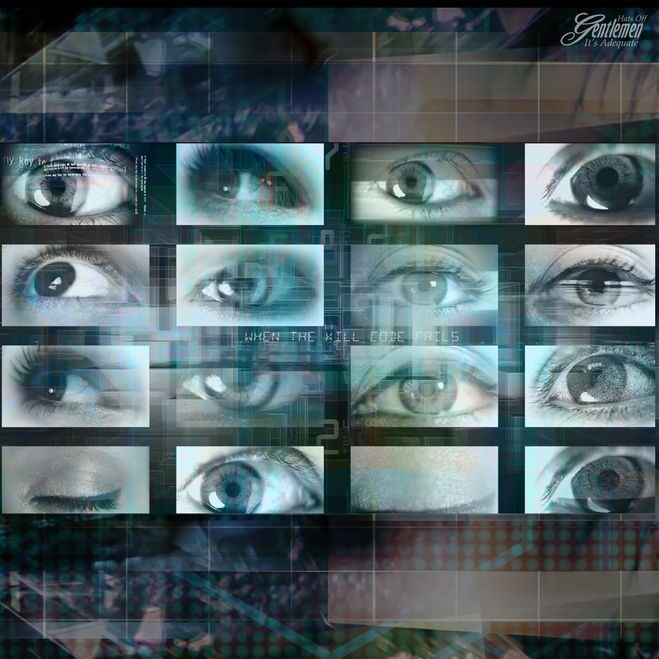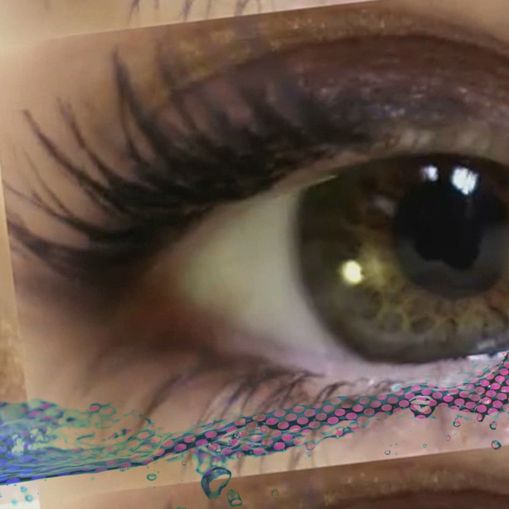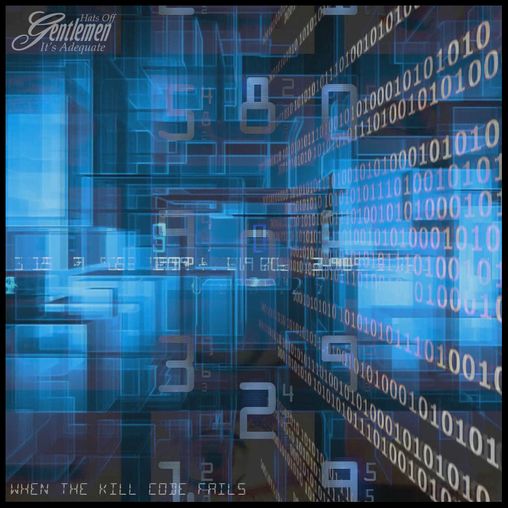

Join our mailing list and get a free song :-)
Videos
Follow on Spotify
Connect with us
When The Kill Code Fails

Official release date 1/1/2016
Hats Off Gentlemen It's Adequate
This page probably more information than you could plausibly want about the When The Kill Code Fails album, but if there's anything else you'd like to know, please do get in touch.
The album follows the story of an artificial character.
1) The first track (When The Kill Code Fails) tells the story of a hacker who is released from prison under a new identity, to work for a government producing computer viruses as targeted weapons. They are supposed to target the infrastructure of enemy states (for example electricity generation, water management etc). The virus he produces spreads further than intended by his employers. He was supposed to provide a kill-code, that makes the virus destroy itself and wipe evidence of it's existence from any systems it has infected. The hacker has however provided a fake kill-code, and is attempting to extort money from his employer in exchange for the real code.
Unfortunately the hacker asks for too much, and rather than negotiating, he is vigorously interrogated, accidentally leading to his death, with no clues as to how to kill the virus.
This song is sung from the point of view of a middle-management level security service employee, who has been contacted by the virtual character (Vic), with an offer to help defeat the virus, if he is allowed out of the restrictions of his virtual room. This is a new experience for the manager, and not something he is comfortable with, but see's little other option, as the predictions are that the virus will soon cause huge damage to IT infrastructure globally.
"We made a deal and he got out of jail free.
With a house and a jar, and a secretary.
A pension and a parking space.
A quiet job in security.
A lifestyle change for a changed man.
What could go wrong?
What a marvelous plan.
I didn’t agree but I went along.
What else could I have done?
When the lights fade
It’s back to the stone age
When the kill code fails.
Watch the code spread from port to port leaving circuits dead.
When the kill code fails.
He made codes that shape things
Codes that break things
He calls them friends.
Friends that do what he wants
And then destroy themselves
And when I ask if it could go too far
He points to the code at the heart of this child.
And it the kill code fails? He smiles, and whispers hide.
We lost the kill code key when he died
On a water board, with a broken heart
No backups, no plans, no riddles, no clues, and his baby on the loose.
This isn’t something I’ve done before.
Talking to something, someone like you.
I wish there was another way, that I could delete your call.
But I don’t think there’s that much left to lose.
Notes: 'I didn't agree but I went along, what else could I have done' isn't a very good excuse. The security agent in this song isn't a hero. The state and agency are deliberately not stated.
2) ‘Broken Wave’. This is a floating instrumental track. The story goes back a few days. We are in a virtual space. An AI research company is aiming to develop more realistic non-player characters for games by evolutionary algorithms. Characters are given a back-story through randomly chosen bits of information from stock photography and video libraries, and from information from the internet. These characters are created, and if they respond engagingly to interaction, their virtual DNA is selected and recombined, to produce every more convincing and engaging characters. The music here represents the nascent aspects of the character floating in and out of focus.
Notes: This track uses a mixture of my Yamaha P90 keyboard's built in sounds, and various synths.
3) ‘Layers’. Iterations of the AI are created, awakening. Those that engage are reborn. Those that don't are deleted. Before the song starts we would have had millions of 'I woke up in a room's without any progression. The song follows our what will become Vic, the first of these AIs to act as if he believes he is alive. His continuing rebirth and gradually changing environment (his room) is confusing and unsettling for him.
"I woke up in a room, it was empty, no ceiling no floor
I woke up in a room, it was empty, no ceiling no floor, no windows no door
Not again, no once again it's happening, I almost got over the edge, and then I pulled it back
I think I got out but I can't remember
What I saw when I saw reality crack
And it's wrong, and it's wrong, and it's wrong and it's wrong and it's wrong
It goes on, it goes, it goes on, it goes on, it goes on,
And still you're wrong
I woke up in a room, it was empty
Just a screen on the wall
And the voice from the screen on the wall
I woke up in a room, and I saw on the desk
The newspapers, books and the rest of the mess
The objects appear but they've always been here
Like I've always been here, Like I've always been here
And the voices in my head
That tell me that tell me there's nothing to fear
When they tell me it's time for bed
And the voices in my head
That tell me that it's OK
That tell me that it's OK, when they tell me it's time to sleep"
Notes: I did this guitar solo, and the electric rhythm parts on my Fender Stratocaster. I've always loved Strats. My first guitar was a Squire Strat. The acoustic guitar parts are on my Yamaha, which is the guitar I use for my solo acoustic shows. The bass was done on my Yamaha bass. These instruments feature throughout the album.
The repeated references to rooms is also a nod towards the Chinese Room thought experiment of John Searle https://en.wikipedia.org/wiki/Chinese_room
4) ‘Connections’. Instrumental. The AI character has access via the screen in his virtual room to the internet. He is exploring and developing.
5) ‘Head In A Jar’. One of the rockiest tracks on the album. The head isn’t really in a jar – it’s a metaphor.
"I was born in a jar, with pipes connected to pumping machines, keeping me clean.
Watching the world outside going by.
I don’t breathe, I don’t speak, in my jar of bottled freak.
I don’t blink. I just think and I feel fine.
I’m a head in a jar, I’m not going anywhere, so why don’t you stay, why are you running away.
Hello to all my invisible friends. Disconnected, unaware. The calm that comes with nothing to defend."
Hopefully it is obvious that the AI doesn't actually feel fine.
Notes - we have a silly video for this - https://www.youtube.com/watch?v=l10huWYJaRY - but may replace this with something more substantial at a later date.
6) ‘Link’ - Instrumental. More exploration of the virtual world.
7) ‘Going Down’. Vic is getting a bit fed up with getting repeatedly confused about what he is. I would like to stress that this is not a song about oral intimacy.
"You tell me my life is a lie
That the people I love fill a hole in my mind
That my mind is a fiction, convictions illusions
My memories fake and my past a delusion
You tell me I'm programmed to say
That I feel what I feel, this is not a display
That I want you to listen, I want you to feel
That the feeling I'm feeling is real
And I'm going down, torn apart again
Twisted up, broken down, run agroud
You tell me there's nothing inside
No place in my room for a mind
That my statements lack meaning, my meanings translations
My words only words, just symbolic notation
You tell me I'm programmed to say
That I feel what I feel, this is not a display
That I want you to listen, I want you to feel
That the fear that I'm feeling is real
Can't you see that I'm lonely
Can't you see that I'm scared
Can't you see that I'm seeing
Fractures in cold air"
8) ‘I Still Remember You’. Vic gets a bit angsty that the person he thought he’d been married to for many years is actually a false memory created from stock photography images. He can intellectually accept that, but not emotionally.
“I know what I've been told
And I've said I understand
How the past is formed
In my kind of life
I know where the pictures are from
I see you've a different life
Not the one that I recall
But something outside
You seem so real
Until I turn you and see
Three dimensions fold
But when I look away you reappear
Painted in hard light
Painted in memory
I was broken from the start
I'm still broken when I think of you
I know what I know
And I feel what I feel
In my artificial life
I still remember you
How many points did it take to
Make me create you?
How many prompts for me to fill in the gaps
To make you feel so real
And when I think I sleep at night
If I still love you
Well if I still love you
Someone please tell me, what does that make me?"
Video link - https://youtu.be/paeebAmU6EQ
Notes - The song started with a chordal guitar riff. Most of the songs on the album had been written at this stage, but I felt that we needed something close to a love song for Vic's unreal wife. The slow fade of elements at the end of the track feels to me like the elements that have fed into creating this artifical memory of a person dissolving.
9) ‘My Clockwork Heart’. This song is about Vic's acceptance of what he is, and his belief in the substrate independence of consciousness.
"Look into my pixelated eyes
Hold the gaze don't turn away
Am I fooling you like I've been fooling me
I get lonely I get tired
And when it's time to say goodnight
Have I been fooling you like I've been fooling me
My clockwork heart still beats
Somewhere inside me.”
Notes: The guitar solo is by Ibon. He was using my Strat for this, although he usually plays Gibson-type guitars live.
10) ‘Freerunning’. Instrumental. Vic has partially escaped his room, and able to interact with the internet. He is running free, exploring his abilities.
Notes - Video link - https://www.youtube.com/watch?v=xb2_GM9Czn8
11) ‘Solace’. Vic has become aware of the threat to both the virtual and non-virtual world posed by the virus. He decides to do what he can to fight the virus. This song is a reflection on mortality, whatever the substrate of our self. He describes 'walking into the sun', by which he means giving up his virtual room, and moving into a more more authentic and dangerous (but still virtual) reality. He is aware that all carbon-based life has evolved from matter recycled from stars, as is the silicon and metals in which his mind is based.
“As I walk into the sun, carry me, carry me. We are made of space and time and stars. Broken stars. Broken stars, carry me."
12) ‘Glass Lithium’. Instrumental. Vic has had his virtual chains unlocked, and is out in the wider internet, dividing himself to attack the virus. Both he and the virus can divide and evolve in response to the attacks and counter-attacks. Vic subdues the virus, although it can't be completely destroyed everywhere. He takes on the role of a protector, diffusely distributed across networks, watching out for a resurgent virus.
13) ‘Alive’. The album ends with a more playful song, with a retro feel. Vic has saved the real world from the effects of the virtual world being virus-ridden (hooray) and has come to terms his identity. He is confident that he is both alive, and passionate about experiencing life. Or at least, he acts as if he believes that he is confident that he is alive... There are lyrical references to the earlier Clockwork Heart song.
"If you look closely you'll see the pixels in my eyes
My dreams and memories, my clockwork heart's disguise
Look into my eyes and see
Nothing where the shadow should be
Look at me and tell me what you see
I’m more alive than I've every been before and I want more
I've been a mirror, I've been a game
I've learned artificial shame
Talk to me and tell me what you hear
I'm a reflection in the dark
I've been a hole in an unmade heart
Hold me and tell me what you feel
I'm more alive than I've ever been before and I want more"
If the album is essentially about whether consciousness is substrate dependent, then the main character in the album, Vic, decides that it isn't. He doesn't feel that the hardware on which the software of self is run is critical to the subjective experience of consciousness.
That's what the character thinks, and I've obviously put words into his mouth. My personal feeling is that we can never be certain what it is like to be in another person's mind, and therefore can't ever know for certain whether a virtual character is actually feeling anything, or just acting in a way that mimics feeling. I suspect they could, but I don't think it could ever be certain. That's without going into the issue of whether any of us are contemporaneously conscious and active agents, but perhaps that's something for another album...
The album was recorded, edited, mixed and mastered on a laptop, using Sonar, apart from some vocal takes, which were recorded with Philip Doyle at the Camden Recording Studios.
In the unlikely event that you've read this far, thanks for your interest, and I hope you enjoy the album. If you've made or would like to make an art-work inspired by the album or any of the tracks, please send me the link and as long as it isn't offensive (eg nothing promoting predjudice etc) then I'd be delighted to include a link here.
Album concept and production by Malcolm Galloway with Mark Gatland and Rudy Burrell.
Malcolm Galloway – vocals (tracks 1,3,5,7, 9, 11, 13), guitar (1,3,4,5,7,8,9,10,11,13), bass (1,3,5,7,9,10,11,13), keyboard/synthesisers (1,2,4,5,6,8,9,10,11,12)
Rudy Burrell – drums (tracks 1, 3, 7, 8)
Mark Gatland – bass (track 8)
Kathryn Thomas – flute (tracks 1, 7)
Ibon Bilbao – guitar (tracks 8 and 9)
Tracks 1, 2, 3, 4, 5, 10, 11, 12, 13 written by Malcolm Galloway
Track 1 by Malcolm Galloway and Rudy Burrell
Track 6 by Malcolm Galloway and Mark Gatland
Track 7 by Malcolm Galloway, Kathryn Thomas and Rudy Burrell
Track 8 by Malcolm Galloway, Ibon Bilbao, Mark Gatland and Rudy Burrell
Track 9 by Malcolm Galloway, Ibon Bilbao, Rudy Burrell
Production by Malcolm Galloway with Kathryn Thomas, Mark Gatland and Kathryn Thomas.
I have referred to the virtual character as he, as I'm singing the songs, but essentially the character is gender neutral.


